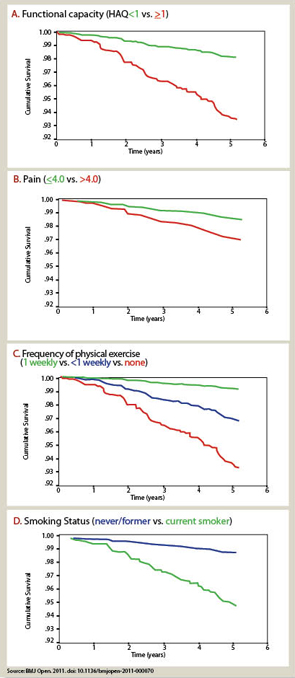
The strength of the biomedical model paradigm may account in large part for limited incorporation of patient self-report data concerning physical function into usual rheumatology care.28 Hypertension and diabetes were transformed to aggressive public health matters through documentation that “tight control” and “treat-to-target” of blood pressure or hemoglobin A1c level led decreased mortality rates. Similarly, it seemed important to document whether reduction of abnormal physical function scores through “treat-to-target” could reduce or even eliminate premature mortality in RA. Achieving this goal requires long-term observational studies since, ethically, clinical trials could not be conducted in a symptomatic disease such as RA over long periods (unlike asymptomatic conditions such as hypertension or hypercholesterolemia).36 However, most rheumatology reports continue to emphasize changes in radiographic and laboratory measures that have far lower significance in the prognosis of RA mortality than self-report questionnaire scores.
A few other rheumatologists have collected clinical databases since the 1980s, generally superior to mine—Fred Wolfe, MD in Wichita; Rolf Rau, MD, in Ratingen, Germany; Tore Kvien, MD, in Oslo, Norway; and Tuulikki Sokka, MD, PhD, in Jyvaskyla, Finland—to pursue “evidence-based” usual rheumatology care. I am grateful to each for their friendship and observations, which often confirmed or anteceded novel, unexpected results, indicating the value of data collection in usual care. Nonetheless, most rheumatology visits are conducted largely as they were 50 years ago when I started in rheumatology as a student—albeit many doctors are typing into an electronic medical record (EMR) instead of writing or dictating.
The Future of MDHAQ
Further developments of the MDHAQ currently in progress include: 1) an electronic version, with automated scoring and entry into a database; 2) report from the four-page MDHAQ in a standard medical history format, entirely from self-report, with no data entry or dictation or typing by the doctor; 3) methods for storage of the medical history data for both doctors and patients, which include the capacity to amend and correct stored information; and 4) integration of MDHAQ/RAPID3 into EMRs, a particularly difficult challenge in view of many incompatible systems, but one that has been solved in some settings. An MDHAQ/RAPID3 in usual care in no way prevents collecting a DAS28, CDAI, ultrasound, or any other measure and assures quantitative data at each visit.
As someone who has conducted basic laboratory investigation and supervised a clinical laboratory, I have found self-reports from questionnaires provide data that are as scientifically valid as laboratory assays, and can provide key information to facilitate patient management and improve outcome. I hope that more health professionals will adopt “evidence-based” approaches to improve patient outcomes. Readers are invited to contact me to help implement an MDHAQ/RAPID3 in their clinic settings.
